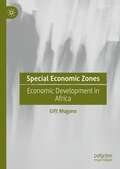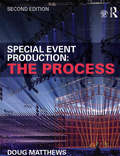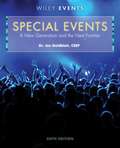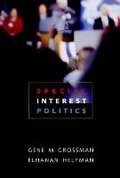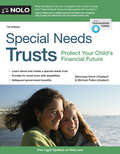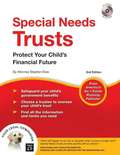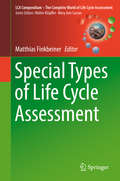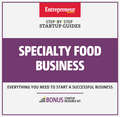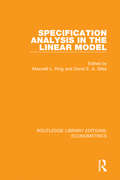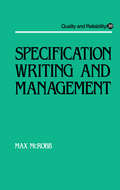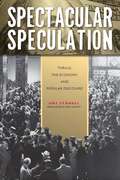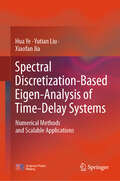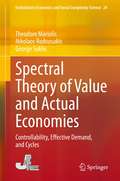- Table View
- List View
Special Economic Zones in South Asia: Structural Change, Competitiveness and Growth (Routledge Studies in Development Economics)
by Aradhna AggarwalGrowth‑enhancing structural change—a relocation of labour from low‑ to high‑productivity sectors—is increasingly perceived as inextricably linked with the sustainable development agenda. In the pursuit of structural change, policymakers have pinned their hopes on targeted policy tools such as special economic zones (SEZs). These geographically demarcated spaces designed to attract investment with a wide set of advantages have become de rigueur; however, a systematic evaluation of evidence‑informed policymaking is scarce due to conceptual and practical challenges. This book fills that gap and shows that SEZs are no ‘shortcut’ to economic development; their success in driving economic transformation depends on the complex interplay of sociopolitical, economic and strategic factors.This book contributes to the burgeoning literature on SEZs by providing the first systematic evaluation of the SEZ policy. It adopts the ‘policy cycle approach’ to organise policy evaluation into three hierarchical layers: input evaluation (agenda building), output evaluation (policy designs) and outcome evaluation (immediate effects of SEZs on firms’ behaviour and performance) with special reference to South Asian countries. The strategy is to bring together the findings of microeconomic evaluations to draw macro inferences on the contribution of SEZs to the broader objectives of structural transformation and competitiveness. Part I of the book delves into development challenges facing the region, lays out theoretical foundations underlying the relevance of SEZs in addressing them and examines the relevance of SEZs in the context of South Asia. Part II evaluates the policy first at systemic level to gauge whether and how the policy is rooted in broader development goals and then at the design level to examine the fit between the policy goals and designs. Part III presents a counterfactual evaluation of the impact of SEZs on investment climate; export competitiveness of firms; technology and innovation; and knowledge linkages of SEZ firms with the wider economy. The final chapter concludes by discussing the emerging challenges and the way forward.This will be a useful reference for academics, researchers, policymakers and professionals in international trade and business, public policy, industrial economics and regional integration.
Special Economic Zones: Economic Development in Africa
by Gift MuganoThis book provides a guide to the challenges of special economic zones. Focusing on Africa, while also discussing China, Taiwan, Dominican Republic, Malaysia, and South Korea, the impact on economic development of special economic zones is analysed to highlight the successes and failures of these zones. New emerging issues, such as the sustainable development goals and the fourth industrial revolution, are presented as factors that need to be addressed in order for special economic zones to be productive in Africa. The role of foreign direct investments, job creation, industrialization, and regulation is also discussed.Special Economic Zones: Economic Development in Africa aims to set out an empirical framework on how to create effective special economic zones. It will be relevant to researchers and policymakers interested in African and development economics.
Special Event Production: The Process
by Doug MatthewsThis must-have guide to special event production resources looks deep behind the scenes of an event and dissects what it is that creates success. It analyses the resources and is an extensive reference guide to the technical details of a big event. It provides a thorough grounding on the specifications and performance of lighting and audio systems, visual presentation technology, special effects and temporary outdoor venues. This new edition includes: New content on: new audio -visual technology, industry safety standards, special effect platforms, décor and new custom forms of staging for both indoor and outdoor events. Updated and new case studies from USA, Canada, India, Russia and Malaysia New Industry Voice feature, including interviews with industry experts from around the world. Comprehensive coverage of venues, staging, seating, rigging, lighting, video, audio, scenic design and décor, CADD, entertainment, special effects, tenting, electrical power, fencing and sanitary facilities in a variety of indoor and outdoor event settings. Enhanced online resources including: PowerPoint lecture slides, checklists, glossaries, additional questions and challenges, web links and video links. Incorporating pedagogical features, this easy-to-read book is packed with photographs, diagrams, flow charts, checklists, sample forms and real-life examples. The vast varieties of audio-visual technologies, outdoor venues, décor and staging are presented. A must have resource for event planners, managers, caterers and students. This text is part two of a two book set - also available is Special Events Production: The Process (978-1-138-78565-6). This book analyses the process - the planning and business aspects - to provide a unique guide to producing a variety of events from weddings to festivals.
Special Event Production: The Process
by Doug MatthewsThis must-have guide to special event production looks deep behind the scenes of an event and dissects what it is that creates success. It analyses the process - the planning and business aspects - to provide a unique guide to producing a variety of events from weddings to festivals. It explains thoroughly budgeting and resource concerns, planning and cost projections and the role of the well-crafted proposal. This new edition has been significantly updated to include: Three new chapters: Event Design, Information Technology and Sustainability and Event Production. Updated and new case studies from USA, Canada , India, Russia and Malaysia. New Industry Voice feature, including an interview with industry experts from around the world commenting on their experiences of event planning and production. New content on: technology, volunteers, venues and PR and marketing. Enhanced online resources including: PowerPoint lecture slides, checklists, glossaries, additional questions and challenges, web links, sample contract templates, production schedule templates, and evaluation forms. Incorporating pedagogical features, this easy-to-read book is packed with photographs, diagrams, flow charts, checklists, sample forms, and real-life examples. It steps through the whole process from the creativity and proposal at the outset, to budgeting, the contract and risk management with event follow up to conclude. A must have resource for event planners, managers, caterers and students. This text is part two of a two book set - also available is Special Events Production: The Resources (978-1-138-78567-0). This book offers an in - depth guide to the technical aspects of a big event such as lighting and audio systems, visual presentation technology, special effects and temporary outdoor venues.
Special Events: A New Generation and the Next Frontier
by Joe GoldblattIntended for students aspiring to be event planners or event leaders, this textbook on the global celebration industry takes a Scottish and global perspective, with many examples drawn from Scotland as well as other parts of the world. The text features case discussion exercises and activities emphasizing corporate social responsibility, global connections, and technology, and offers profiles of professionals around the world, plus color and b&w photos. After an introduction to the theory of event leadership, coverage encompasses event administration and coordination, marketing, legal and ethical issues, and risk management, with a final section on technology for professional development. The text includes a list of books, websites, organizations, and suppliers related to green approaches in event planning. This sixth edition emphasizes how events use rituals and ceremonies to promote continuity and stability in human communities, and contains new chapters on environmental sustainability and corporate social responsibility. There are also new case studies, including the 2008 Summer Olympics and the Homecoming Scotland 2009 celebrations. Goldblatt is affiliated with Queen Margaret University. Annotation ©2011 Book News, Inc. , Portland, OR (booknews. com)
Special Interest Politics
by Gene M. Grossman Elhanan HelpmanWinner of 2002 William H. Riker Award for Best Book in Political Economy, presented by the American Political Science Association (APSA). This landmark theoretical book is about the mechanisms by which special interest groups affect policy in modern democracies. Defining a special interest group as any organization that takes action on behalf of an identifiable group of voters, Gene Grossman and Elhanan Helpman ask: How do special interest groups derive their power and influence? What determines the extent to which they are able to affect policy outcomes? What happens when groups with differing objectives compete for influence? The authors develop important theoretical tools for studying the interactions among voters, interest groups, and politicians. They assume that individuals, groups, and parties act in their own self-interest and that political outcomes can be identified with the game-theoretic concept of an equilibrium. Throughout, they progress from the simple to the more complex. When analyzing campaign giving, for example, they begin with a model of a single interest group and a single, incumbent policy maker. They proceed to add additional interest groups, a legislature with several independent politicians, and electoral competition between rival political parties. The book is organized in three parts. Part I focuses on voting and elections. Part II examines the use of information as a tool for political influence. Part III deals with campaign contributions, which interest groups may use either to influence policy makers' positions and actions or to help preferred candidates to win election.
Special Interest Tourism
by Sheela Agarwal Graham Busby Rong HuangSpecial interest tourism is growing rapidly, due to a discerning and heterogeneous travel market and the demand for more focused activity or interest-based tourism experiences. This book approaches the topic from the perspective of both supply and demand, and has a clear, user-friendly structure. Covering the practical applications of research and the key emerging issues for royal, dark, festival, sport, gastronomic, slow and pro-poor tourism among others, it includes contributions and case studies by international academics and practitioners. Sometimes referred to as niche or contemporary tourism, this book provides a complete introduction to the study of special interest tourism for students.
Special Interest Tourism: Concepts, Contexts and Cases
by Ralf Buckley Lynn Minnaert Ade Oriade Dallen Timothy Allan Watson Carol Southall Nazia Ali Glen Croy Steven Rhoden Alison Caffyn Richard Benfield Cheng-Fei LeeSpecial interest tourism is growing rapidly due to a discerning and heterogeneous travel market and the demand for more focused activity or interest-based tourism experiences. This book approaches the topic from the perspective of both supply and demand, and addresses the complexities now inherent in this area of tourism. It presents a contextualised overview of contemporary academic research, concepts, principles and industry-based practice insights, and also considers the future of special interest tourism in light of the emergence of ethical consumerism. With a clear, user-friendly structure, the book: -Links theoretical frameworks to clear practical applications. -Reviews key emerging issues for tourism relating to families and faith, the performing arts, active and passive pursuits, therapeutic leisure and travelling. -Includes contributions and case studies from international academics and practitioners to give a truly global overview. Sometimes referred to as niche or contemporary tourism, this book provides a complete introduction to the study of special interest tourism for students.
Special Needs Trusts: Protect Your Child's Financial Future
by Kevin Urbatsch Michele Fuller-UrbatchSpecial Needs Trusts shows you how to leave any amount of money to your disabled loved one -- without jeopardizing government benefits. It provides plain-English information and forms you need to create a special needs trust. Funds in a special needs trust can make a big difference in quality of life by paying for: annual independent check-ups personal care attendant or escort vehicles and transportation insurance rehabilitation essential dietary needs materials for recreation trips or vacations entertainment athletic training or competitions, and much more. Special Needs Trusts also provides a formal letter to the trustee, which explains this very important role, and a personal letter to the trustee, which provides crucial information about your loved one. Author Kevin Urbastch gives you an experienced perspective about when to make a special needs trust on your own and when to seek the services of an attorney. This edition has been thoroughly revised to provide: current eligibility requirements for government benefits helpful resources a new chapter on letters of intent a new chapter on ABLE accounts
Special Needs Trusts: Protect Your Child's Financial Future
by Kevin Urbatsch Michele Fuller-UrbatchLeave money to a loved one with a disability—without losing benefits Use a special needs trust to provide financial security for your child (or anyone) with a disability, without jeopardizing important government benefits. Funds in a special needs trust do not count against eligibility for benefits and can be used to improve the quality of your child’s life. This book provides everything you need to know about special needs trusts—whether you make one yourself or have an attorney draft one for you. The authors explain: how special needs trusts work the trustee’s role ways to pass important information to successor trustees the pros and cons of joining a pooled trust, and creating special needs trust with or without a lawyer. This edition is thoroughly updated and includes new chapters on ABLE accounts and letters of intent. All forms are downloadable through a special link in the book.
Special Needs Trusts: Protect Your Child's Financial Future (2nd edition)
by Stephen EliasIf you care for a child or other loved one with a disability, you've no doubt thought about what will happen when you're no longer able to give that care. Fortunately, there's a simple solution to this dilemma -- create a "special needs trust." Special Needs Trusts shows you how to leave any amount of money to your disabled loved one, without jeopardizing government benefits. It provides plain-English information and forms that let you create a special needs trust by modifying your will or living trust document.
Special Types of Life Cycle Assessment
by Matthias FinkbeinerThis book presents specialised methods and tools built on classical LCA. In the first book-length overview, their importance for the further growth and application of LCA is demonstrated for some of the most prominent species of this emerging trend: Carbon footprinting; Water footprinting; Eco-efficiency assessment; Resource efficiency assessment; Input-output and hybrid LCA; Material flow analysis; Organizational LCA. Carbon footprinting was a huge driver for the market expansion of simplified LCA. The discussions led to an ample proliferation of different guidelines and standards including ISO/TS 14067 on Carbon Footprint of Product. Atsushi Inaba (Kogakuin University, Tokyo, Japan) and his eight co-authors provide an up-to-date status of Carbon Footprint of Products. The increasing relevance of Water Footprinting and the diverse methods were the drivers to develop the ISO 14046 as international water footprint standard. Markus Berger (Technische Universität Berlin, Germany), Stephan Pfister (ETH Zurich, Switzerland) and Masaharu Motoshita (Agency of Industrial Science and Technology, Tsukuba, Japan) present a status of water resources and demands from a global and regional perspective. A core part is the discussion and comparison of the different water footprint methods, databases and tools. Peter Saling from BASF SE in Ludwigshafen, Germany, broadens the perspective towards Eco-efficiency Assessment. He describes the BASF-specific type of eco-efficiency analysis plus adaptions like the so-called SEEBALANCE and AgBalance applications. Laura Schneider, Vanessa Bach and Matthias Finkbeiner (Technische Universität Berlin, Germany) address multi-dimensional LCA perspectives in the form of Resource Efficiency Assessment. Research needs and proposed methodological developments for abiotic resource efficiency assessment, and especially for the less developed area of biotic resources, are discussed. The fundamentals ofInput-output and Hybrid LCA are covered by Shinichiro Nakamura (Waseda University, Tokyo, Japan) and Keisuke Nansai (National Institute for Environmental Studies, Tsukuba, Japan). The concepts of environmentally extended IO, different types of hybrid IO-LCA and the waste model are introduced. David Laner and Helmut Rechberger (Vienna University of Technology, Austria) present the basic terms and procedures of Material Flow Analysismethodology. The combination of MFA and LCA is discussed as a promising approach for environmental decision support. Julia Martínez-Blanco (Technische Universität Berlin, Germany; now at Inèdit, Barcelona, Spain), Atsushi Inaba (Kogakuin University, Tokyo, Japan) and Matthias Finkbeiner (Technische Universität Berlin, Germany) introduce a recent development which could develop a new trend, namely the LCA of Organizations.
Special and Differential Treatment Reform in the WTO: 'The Differentiated Differentiation Approach
by Aniekan UkpeThis book proposes a new approach to differentiating between developing countries in the context of special and differential treatment (SDT) in the World Trade Organisation.Offering unique insights into SDT reform in the WTO, the book proposes the method of differentiated differentiation and demonstrates its operationalization using the WTO Customs Valuation Agreement. Through identifying key indicators to categorize constraints faced by developing countries, the book establishes objective criteria to depoliticize access to SDT. Promoting a case-by-case approach, the book also employs a statistics-based score procedure to determine a threshold for graduating countries out of SDT. Through flexible tracking and evidence-based arguments, the book provides a transitional method of reform which maintains full compliance with WTO members’ obligations.The book will be of importance to academics and students of international law, especially those with an interest in international trade law and the WTO, as well as legal professionals and policymakers.
Specialty Food Business
by The Staff of Entrepreneur MediaFueled by growing consumer demand for new tastes, cleaner ingredients, health benefits, and more convenient ways to shop and eat, the business of specialty food is taking off at full speed. This step-by-step guide tells creative cooks and aspiring entrepreneurs how to make sure they're not left behind.Armed with a detailed overview of the specialty and gourmet food industry including how it differs from other food businesses, today's and tomorrow's trends, important research and statistics, and more, entrepreneurial foodies gain insight into industry growth drivers and opportunities.Covering behind-the-scenes business models and retailing businesses within specialty food, the experts of Entrepreneur help new entrepreneurs determine their best business approach assessing what they need to startup, expected expenses, the market, and competition. Location options, retail or production space, are explored and readers are given a lesson in all things digital.Coached by practicing entrepreneurs, aspiring business owners are also given first-hand insight with tales from the trenches including advice and tips on unique considerations within the food business, and important lessons in planning for the long term.The how-to provided is supported with worksheets, samples, and resource lists.
Specialty Medical Chemicals
by Richard G. Hamermesh Lucinda DoranA new general manager is supposed to rekindle growth. Seven months later, he questions the abilities of his direct reports. An organizational psychologist is brought in to assess his people. The general manager now has to decide who to keep and how to structure his direct report team.
Specification Analysis in the Linear Model (Routledge Library Editions: Econometrics #11)
by Maxwell L. King David E. A. GilesOriginally published in 1987. This collection of original papers deals with various issues of specification in the context of the linear statistical model. The volume honours the early econometric work of Donald Cochrane, late Dean of Economics and Politics at Monash University in Australia. The chapters focus on problems associated with autocorrelation of the error term in the linear regression model and include appraisals of early work on this topic by Cochrane and Orcutt. The book includes an extensive survey of autocorrelation tests; some exact finite-sample tests; and some issues in preliminary test estimation. A wide range of other specification issues is discussed, including the implications of random regressors for Bayesian prediction; modelling with joint conditional probability functions; and results from duality theory. There is a major survey chapter dealing with specification tests for non-nested models, and some of the applications discussed by the contributors deal with the British National Accounts and with Australian financial and housing markets.
Specification Writing and Management
by Max McrobbThis book deals with the fundamentals of specification writing and management. It is useful for anyone concerned with the preparation of standards in a world that is shrinking due to improvement in communication and where many specifications have to hold clarity when translated into other languages.
Spectacular Speculation: Thrills, the Economy, and Popular Discourse
by Urs Staheli Eric SavothSpectacular Speculationis a history and sociological analysis of the semantics of speculation from 1870 to 1930, when speculation began to assume enormous importance in popular culture. Informed by the work of Luhmann, Foucault, Simmel and Deleuze, it looks at how speculation was translated into popular knowledge and charts the discursive struggles of making speculation a legitimate economic practice. Noting that the vocabulary available to discuss the concept was not properly economic, the book reveals the underside of putting it into words. Speculation's success depended upon non-economic language and morally questionable thrills: a proximity to the wasteful practice of gambling or other "degenerate" behaviors, the experience of financial markets as seductive, or out of control. American discourses of speculation take center stage, and the book covers an unusual range of material, including stock exchange guidebooks, ticker tape, moral treatises, plays, advertisements, and newspapers.
Specters of the Atlantic: Finance Capital, Slavery, and the Philosophy of History
by Ian BaucomIn September 1781, the captain of the British slave ship Zong ordered 133 slaves thrown overboard, enabling the ship's owners to file an insurance claim for their lost "cargo. " Accounts of this horrific event quickly became a staple of abolitionist discourse on both sides of the Atlantic. Ian Baucom revisits, in unprecedented detail, the Zong atrocity, the ensuing court cases, reactions to the event and trials, and the business and social dealings of the Liverpool merchants who owned the ship. Drawing on the work of an astonishing array of literary and social theorists, including Walter Benjamin, Giovanni Arrighi, Jacques Derrida, and many others, he argues that the tragedy is central not only to the trans-Atlantic slave trade and the political and cultural archives of the black Atlantic but also to the history of modern capital and ethics. To apprehend the Zong tragedy, Baucom suggests, is not to come to terms with an isolated atrocity but to encounter a logic of violence key to the unfolding history of Atlantic modernity. Baucom contends that the massacre and the trials that followed it bring to light an Atlantic cycle of capital accumulation based on speculative finance, an economic cycle that has not yet run its course. The extraordinarily abstract nature of today's finance capital is the late-eighteenth-century system intensified. Yet, as Baucom highlights, since the late 1700s, this rapacious speculative culture has had detractors. He traces the emergence and development of a counter-discourse he calls melancholy realism through abolitionist and human-rights texts, British romantic poetry, Scottish moral philosophy, and the work of late-twentieth-century literary theorists. In revealing how the Zong tragedy resonates within contemporary financial systems and human-rights discourses, Baucom puts forth a deeply compelling, utterly original theory of history: one that insists that an eighteenth-century atrocity is not past but present within the future we now inhabit.
Spectio: A Digital Lighting Company
by Rajiv Lal Sarah McaraSpectio Tech, founded in 2005, developed and implemented intelligent LED lighting solutions for the industrial market. Sensors and wireless connectivity embedded in its LED fixtures not only significantly reduced lighting-related energy use-by up to 90% in some cases-but also served as a tool for the Internet of Things (IoT) to expose powerful insights about facility use. Yet in 2016, few of Spectio's customers were fully embracing the system as an IoT product. Both LED lighting and IoT were rapidly evolving markets, and Spectio had to decide if it should focus on driving down lighting hardware costs to expand its total addressable market or on improving the software controls to enhance the system's IoT functionality.
Spectio: A Digital Lighting Company
by Rajiv Lal Sarah McaraSpectio Tech, founded in 2005, developed and implemented intelligent LED lighting solutions for the industrial market. Sensors and wireless connectivity embedded in its LED fixtures not only significantly reduced lighting-related energy use-by up to 90% in some cases-but also served as a tool for the Internet of Things (IoT) to expose powerful insights about facility use. Yet in 2016, few of Spectio's customers were fully embracing the system as an IoT product. Both LED lighting and IoT were rapidly evolving markets, and Spectio had to decide if it should focus on driving down lighting hardware costs to expand its total addressable market or on improving the software controls to enhance the system's IoT functionality.
Spectral Discretization-Based Eigen-Analysis of Time-Delay Systems: Numerical Methods and Scalable Applications
by Hua Ye Yutian Liu Xiaofan JiaThis book focuses on the partial spectral discretization (PSD)-based eigenvalue computation methods for large-scale time-delay systems. Due to past-dependence in the evolution of a system, time delays may greatly affect the system’s dynamics. For example, wide-area damping controllers in the interconnected power systems are fed by remote synchrophasor measurements and thus inevitably introduce time delays into the control loop. These delays ranging from tens to hundreds of milliseconds can deteriorate the performance of the controllers and further jeopardize the power system stability. Therefore, this book addresses two classes of efficient eigenvalue computation methods for time-delay systems based on the PSD idea, as well as their applications to power systems with inclusion of time delays. The methods are expected to obtain the accurate stability boundary of time-delay systems with affordable computational burden. This book would appeal to engineers, researchers and graduate students in power and control engineering, as well as computational and applied mathematicians.
Spectral Feature Selection for Data Mining (Chapman And Hall/crc Data Mining And Knowledge Discovery Ser.)
by Huan Liu Zheng Alan ZhaoSpectral Feature Selection for Data Mining introduces a novel feature selection technique that establishes a general platform for studying existing feature selection algorithms and developing new algorithms for emerging problems in real-world applications. This technique represents a unified framework for supervised, unsupervised, and semisupervise
Spectral Theory of Value and Actual Economies: Controllability, Effective Demand, and Cycles (Evolutionary Economics and Social Complexity Science #24)
by Theodore Mariolis Nikolaos Rodousakis George SoklisThis book develops a unified treatment of the income distribution–capital–value problems with respect to actual economies, and then gradually turns to the issues of effective demand and capitalist accumulation fluctuations from both political economy and economic policy perspectives. That treatment, on the one hand, places produced means of production, positive profits, and capital accumulation at the centre of the analysis and, on the other hand, is analytically based on the modern control theory. Hence, the authors’ investigation is concerned with input–output representations of actual single and joint production, heterogeneous labour, and open economies; zeroes in on the characteristic value distributions of the system matrices; and, finally, derives meaningful theoretical results consistent with the empirical evidence, and vice versa. The main topics addressed are the uncontrollable/unobservable aspects of the real-world economies, the powerful low-order spectral approximations and reconstructions of the inter-industry structure of production–value–distributive variables relationships, the critical-constructive appraisal of both “mainstream” and “radical” theories of value, the matrix demand multipliers and demand-switching policies in heterogeneous capital worlds, and the circular inter-actions amongst income distribution, effective demand, accumulation, and technical conditions of production. Written on the occasion of the 60th anniversary of the publication of both Piero Sraffa’s Production of Commodities by Means of Commodities and Rudolf E. Kalman’s paper “On the general theory of control systems”, this book provides a consistent and comprehensive framework for theoretical, empirical, and economic policy research.
Spectroscopic Tools and Techniques for Analysis of Dental Materials: Current Trends
by Ashutosh Kumar ShuklaSpectroscopic Tools and Techniques for Analysis of Dental Materials: Current Trends introduces the dental materials and spectroscopic techniques applied for the analysis of such materials, including ceramic, metallic, polymeric and composites. The following individual chapters are primarily based on particular spectroscopic techniques and their applications, including X-ray Spectroscopy, Ultraviolet & visible spectroscopy, Fourier Transfer Infrared Spectroscopy, Raman Spectroscopy and Mass spectrometry. Different oral diseases, caries, calculus, periodontitis and oral mucosal diseases such as oral cancer, will be discussed as well.This is an ideal book for dental professionals, researchers and students interested in the analysis of dental materials.Key Features: Individual chapters include brief introductions of specific techniques Mathematical details are kept at a necessary minimum level Includes case studies to suit the target audience

